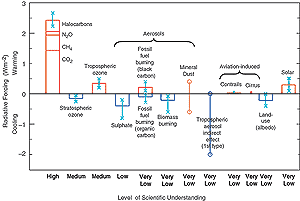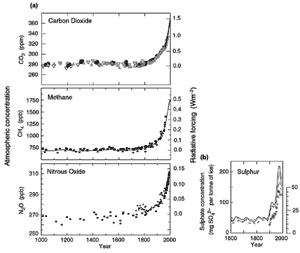|

Figure 9: Global, annual-mean radiative forcings (Wm-2)
due to a number of agents for the period from pre-industrial (1750) to
present (late 1990s; about 2000) (numerical values are also listed in
Table 6.11 of Chapter 6).
For detailed explanations, see Chapter 6.13. The
height of the rectangular bar denotes a central or best estimate value,
while its absence denotes no best estimate is possible. The vertical line
about the rectangular bar with “x” delimiters indicates an estimate of
the uncertainty range, for the most part guided by the spread in the published
values of the forcing. A vertical line without a rectangular bar and with
“o” delimiters denotes a forcing for which no central estimate can be
given owing to large uncertainties. The uncertainty range specified here
has no statistical basis and therefore differs from the use of the term
elsewhere in this document. A “level of scientific understanding” index
is accorded to each forcing, with high, medium, low and very low levels,
respectively. This represents the subjective judgement about the reliability
of the forcing estimate, involving factors such as the assumptions necessary
to evaluate the forcing, the degree of knowledge of the physical/chemical
mechanisms determining the forcing, and the uncertainties surrounding
the quantitative estimate of the forcing (see Table
6.12). The well-mixed greenhouse gases are grouped together into a
single rectangular bar with the individual mean contributions due to CO2,
CH4, N2O and halocarbons shown (see Tables
6.1 and 6.11). Fossil fuel burning is
separated into the “black carbon” and “organic carbon” components with
its separate best estimate and range. The sign of the effects due to mineral
dust is itself an uncertainty. The indirect forcing due to tropospheric
aerosols is poorly understood. The same is true for the forcing due to
aviation via its effects on contrails and cirrus clouds. Only the “first”
type of indirect effect due to aerosols as applicable in the context of
liquid clouds is considered here. The “second” type of effect is conceptually
important, but there exists very little confidence in the simulated quantitative
estimates. The forcing associated with stratospheric aerosols from volcanic
eruptions is highly variable over the period and is not considered for
this plot (however, see Figure 6.8). All the
forcings shown have distinct spatial and seasonal features (Figure
6.7) such that the global, annual means appearing on this plot do
not yield a complete picture of the radiative perturbation. They are only
intended to give, in a relative sense, a first-order perspective on a
global, annual mean scale and cannot be readily employed to obtain the
climate response to the total natural and/or anthropogenic forcings. As
in the SAR, it is emphasised that the positive and negative global mean
forcings cannot be added up and viewed a priori as providing offsets in
terms of the complete global climate impact. [Based on Figure
6.6]
|

